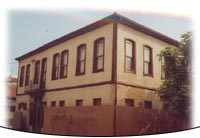Konya - Akşehir Western Front Headquarters Museum
 After the victory of the Major Battle of Sakarya, the enemy took up a position in the east of Afyon - Eskisehir line. Because of this, the western front headquarters was moved from the village of Alagöz to Aksehir. On the 18th of November 1921 the headquarters moves in to the municipality building in Aksehir and works there until 24th August 1922, the day it moves to the Front. Within this nine and a half months period the Great Offensive preparations were directed from here and the decisions were given here in this building. Meanwhile many times Mustafa Kemal comes to Aksehir inspects the work and directs the preparations. The building was constructed as the municipality building by the mayor Bostan Bey between the years 1904 - 1905. This two-storey building had a stone foundation and the walls were made of brick and lathwork. The front sides of the shops that were on the east and the west sides of the building were covered up and wall panels made showing the pictures of the preparations and of the Grand Offensive by using graffito technique.
After the victory of the Major Battle of Sakarya, the enemy took up a position in the east of Afyon - Eskisehir line. Because of this, the western front headquarters was moved from the village of Alagöz to Aksehir. On the 18th of November 1921 the headquarters moves in to the municipality building in Aksehir and works there until 24th August 1922, the day it moves to the Front. Within this nine and a half months period the Great Offensive preparations were directed from here and the decisions were given here in this building. Meanwhile many times Mustafa Kemal comes to Aksehir inspects the work and directs the preparations. The building was constructed as the municipality building by the mayor Bostan Bey between the years 1904 - 1905. This two-storey building had a stone foundation and the walls were made of brick and lathwork. The front sides of the shops that were on the east and the west sides of the building were covered up and wall panels made showing the pictures of the preparations and of the Grand Offensive by using graffito technique.
This headquarters building which documents the days of hope and struggle, after the movement of the municipality office to another building in 1965, it was donated to the Ministry on the condition that it will be a museum. After a big repair, on 5th July 1966, it was opened to visitors as Atatürk and the ethnographical museum. After the repairs and rearrangements it was renamed to its present name due to original functions of its time.
The administrative section is located in the ground floor of the museum. The top floor still have the original materials from the head quarter days. The room in the south corner is the Atatürk’s study and the place where the Great Offensive decision was taken. The rooms in both sides of this room are the studies of Ismet Inönü and the General Staff Chief Asim Gündüz. The wax statue of Ismet Pasha was placed on the study desk. The room in the northern corner exhibits the gifts given to the Great Leader, belongings used by him and his weapons.
In the other four rooms biographies of officers worked in the headquarters, quotations from the “Speech” panels, photographs, maps, documents and weapons are in exhibit.